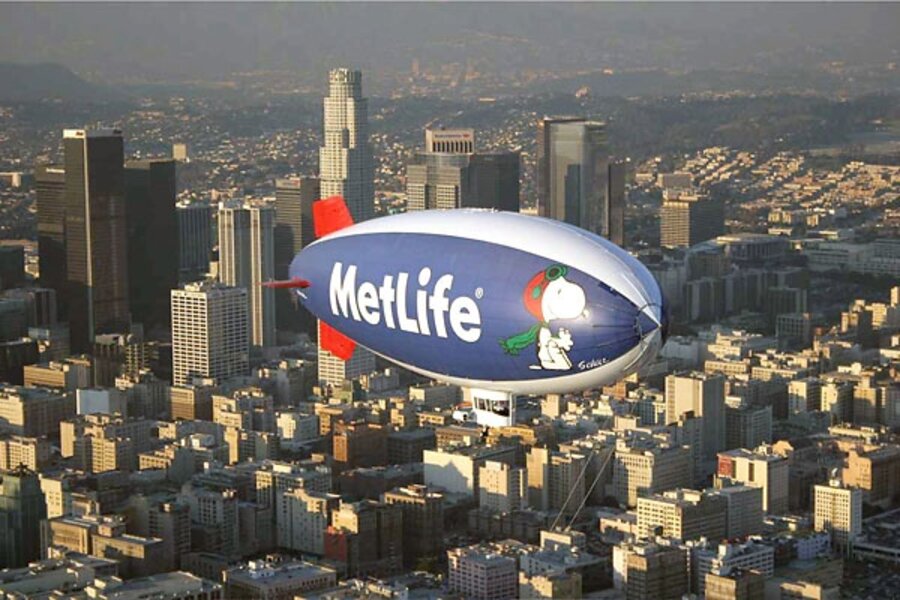More US insurance companies eye federal aid
Loading...
| New York
Some of America’s biggest names in insurance are in line for a loan from Uncle Sam.
Last fall, many of them bought small banks or thrifts, in the hope this would qualify them to get some federal help. The insurance companies include names familiar to millions of Americans: the Prudential Financial, Hartford Financial, and Lincoln Financial. But hardly anyone has heard of the banks they bought.
Nonetheless, in the next several weeks, the government will announce if these banks – make that insurance companies – will receive government assistance.
In recent weeks, the insurance industry has been promoting its importance to the nation’s financial well-being, noting that it touches millions of Americans by providing life and health insurance and annuities. The companies often portray themselves as prudent as grandparents, and in marketing, they use warm and fuzzy images such as Snoopy the cartoon figure or geographic locations such as the Rock of Gibraltar. Many of them have loans out to real estate developments all over Main Street.
“Collectively they touch everyone, and they are the linchpin for retirement for America,” says Bob Litan, a senior fellow at the Brookings Institution in Washington. “It would shatter public confidence, at a time when public confidence is already pretty fragile, if the private version of Social Security were to fail.”
According to the American Council of Life Insurers, the industry has some $4.9 trillion invested in the US economy. Life insurers are the largest source of bond financing, with some $1.6 trillion invested in 2007.
Although it’s still early in the process, the insurance companies will need $50 billion to $70 billion, Mr. Litan estimates. “It’s a lot of money even in these days, but it’s more manageable than the banking industry,” he says.
On Wednesday, the US Treasury replied to a report in The Wall Street Journal that said it was within days of announcing aid for the insurance industry. In a statement, the Treasury said, "There are a number of life insurers who met the requirements for the Capital Purchase Program because of their thrift or bank holding status and applied within appropriate deadlines. These are among the hundreds of financial institutions in the CPP pipeline that will be reviewed and funded as appropriate on a rolling basis."
Any decisions will probably not come for weeks.
The CPP is a $250 billion program that is part of the Troubled Asset Relief Program. The program allows banks and thrifts to borrow money, but they must pay dividends to the taxpayers and return the money. Government officials stress it is not a bailout. Perhaps fewer than 10 insurance companies might qualify for the loans.
The industry has been buffeted by three factors, Litan says. Many of them have large stock portfolios that have gone down in value during the bear market.
Many of the companies also have written annuities, which promise to pay a fixed rate or variable rate of return. However, an insurance company can’t meet its annuity obligations if the company’s assets, such as mortgage loans, are not performing.
And some of the companies, Litan says, may be suffering from the equivalent of a run on the bank, as policyholders redeem the cash values of their policies or roll over investments into other financial institutions.
The industry could thus be facing massive losses.
MetLife, the biggest life insurer in the United States, could face multibillion-dollar losses this year. Its unrealized losses – which refers to a drop in the value of stocks, bonds, and other assets it holds – total $30 billion this year, according to industry research firm CreditSights. If the company is forced to sell those securities at today’s deflated prices to meet this year’s obligations, the losses would be substantial.
MetLife spokesman Chris Breslin declined to say Wednesday whether the company plans to use TARP money, if needed, to offset any losses. He instead touts the company’s $5 billion in excess capital to meet its obligations.
MetLife has been a bank holding company since 2001, meaning it has been eligible for a loan for some time. But several other insurers have scrambled in recent months to buy small or troubled savings and loans and other bank holding companies to be eligible for government funds.
In November, for example, insurance giant Hartford Financial, which has $347 billion in assets under management, agreed to purchase troubled Federal Trust Bank, based in Sanford, Fla., with assets of $602 million. Hartford recently infused $20 million into the bank as it attempts to complete the acquisition, which is still pending. If the deal is completed, the insurer could get CPP funds of as much as $3.4 billion.
Lincoln Financial made an even smaller acquisition. In November, the company, with $178 billion in assets under management, announced it would buy Newton County Loan & Savings, with assets of $6.6 million. Newton is a 115-year-old thrift based in Goodland, Ind. (pop. 1,096). Lincoln could be eligible for $1.7 billion to $5.3 billion in CPP funds.
Lincoln is exposed to potentially troubled commercial mortgage loans and securities based on those loans, which is a factor in a recent rating downgrade of the company, says A.M. Best analyst Rosemarie Mirabella.
This week, Lincoln Financial president and CEO Dennis Glass tried to assure policyholders that the company will weather the storm, touting a conservative investment approach. Short-term debt is “at or below prior years,” the company said in a release, highlighting the repayment of $500 million in mature debt, plus plans to repay $200 million in short-term borrowings in the next few weeks.
Insurers who partake of government loans will have to abide by the rules – including rules on executive compensation. No CEO of a TARP participant can earn more than $500,000 in salary.
Last year, C. Robert Henrikson – board chairman, CEO, and president of MetLife – earned $24.4 million in salary and other compensation. Mr. Glass earned $17 million.





